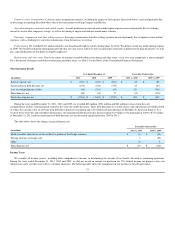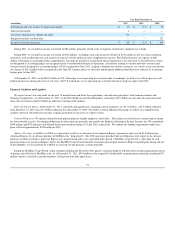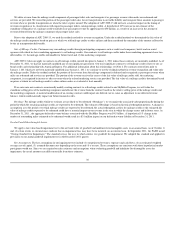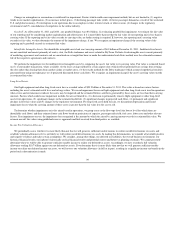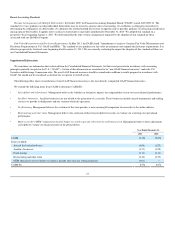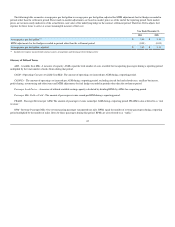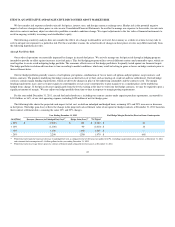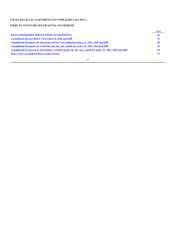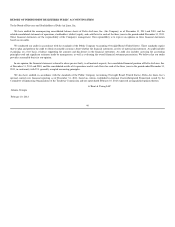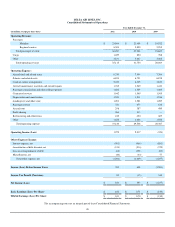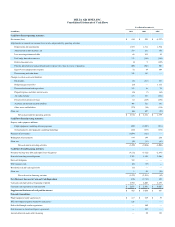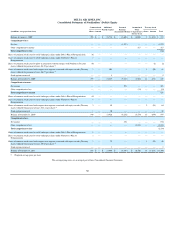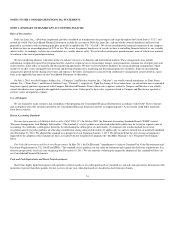Delta Airlines 2011 Annual Report Download - page 49
Download and view the complete annual report
Please find page 49 of the 2011 Delta Airlines annual report below. You can navigate through the pages in the report by either clicking on the pages listed below, or by using the keyword search tool below to find specific information within the annual report.
ITEM 7A. QUANTITATIVE AND QUALITATIVE DISCLOSURES ABOUT MARKET RISK
We have market risk exposure related to aircraft fuel prices, interest rates, and foreign currency exchange rates. Market risk is the potential negative
impact of adverse changes in these prices or rates on our Consolidated Financial Statements. In an effort to manage our exposure to these risks, we enter into
derivative contracts and may adjust our derivative portfolio as market conditions change. We expect adjustments to the fair value of financial instruments to
result in ongoing volatility in earnings and stockholders' equity.
The following sensitivity analysis does not consider the effects of a change in demand for air travel, the economy as a whole or actions we may take to
seek to mitigate our exposure to a particular risk. For these and other reasons, the actual results of changes in these prices or rates may differ materially from
the following hypothetical results.
Aircraft Fuel Price Risk
Our results of operations are materially impacted by changes in aircraft fuel prices. We actively manage our fuel price risk through a hedging program
intended to provide an offset against increases in jet fuel prices. This fuel hedging program utilizes several different contract and commodity types, which are
used together to create a risk mitigating hedge portfolio. The economic effectiveness of this hedge portfolio is frequently tested against our financial targets.
The hedge portfolio is rebalanced from time to time according to market conditions, which may result in locking in gains or losses on hedge contracts prior to
their settlement dates.
Our fuel hedge portfolio generally consists of call options; put options, combinations of two or more call options and put options; swap contracts; and
futures contracts. The products underlying the hedge contracts are derivatives of jet fuel, such as heating oil, crude oil and low sulfur diesel. Our fuel hedge
contracts contain margin funding requirements, which are driven by changes in price of the underlying commodity and the contracts used. The margin
funding requirements may cause us to post margin to counterparties or may cause counterparties to post margin to us as market prices in the underlying
hedged items change. If fuel prices decrease significantly from the levels existing at the time we enter into fuel hedge contracts, we may be required to post a
significant amount of margin . We may adjust our hedge portfolio from time to time in response to margin posting requirements.
For the year ended December 31, 2011, aircraft fuel and related taxes, including our contract carriers under capacity purchase agreements, accounted for
$11.8 billion, or 36%, of our total operating expense, including $420 million of net fuel hedge gains.
The following table shows the projected cash impact to fuel cost, on both an unhedged and hedged basis, assuming 10% and 20% increases or decreases
in fuel prices. The hedge gain (loss) reflects the change in the projected cash settlement value of our open fuel hedge contracts at December 31, 2011 based on
their contract settlement dates, assuming the same 10% and 20% changes.
Year Ending December 31, 2012 Fuel Hedge Margin (Posted to) Received from Counterparties
(in millions) Decrease (Increase) to Unhedged Fuel Cost(1) Hedge Gain (Loss)(2) Net Impact
+ 20% $ (2,200) $ 120 $ (2,080) $ 40
+ 10% (1,100) 90 (1,010) $ 10
- 10% 1,100 (100) 1,000 $ —
- 20% 2,200 (230) 1,970 $ (60)
(1) Projections based upon the (increase) decrease to unhedged fuel cost as compared to the jet fuel price per gallon of $2.94, excluding transportation costs and taxes, at December 31, 2011
and estimated fuel consumption of 3.8 billion gallons for the year ending December 31, 2012.
(2) Projections based on average futures prices by contract settlement month compared to futures prices at December 31, 2011.
43


